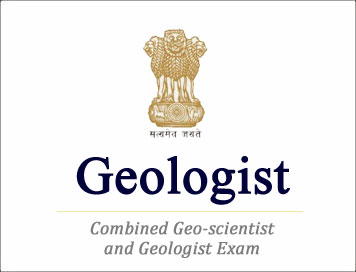(HOT) UPSC Current Affairs 2025 PDF
NEW! The Gist (NOV-2025) | E-BOOKS
UPSC Geo-Scientist and Geologist Exam Papers 2019 : Hydrogeology

(Download) UPSC: Geologist Examination Papers-2019
Exam Name : UPSC Geo-Scientist and Geologist Exam 2019
Subject : Hydrogeology
Year : 2019
HYDROGEOLOGY
Time Allowed : Three Hours
Maximum Marks : 200
QUESTION PAPER SPECIFIC INSTRUCTIONS
Please read each of the following instructions carefully before attempting questions.
There are NINE questions divided under FIVE Sections.
Candidate has to attempt FIVE questions in all.
The ONLY question in Section A is compulsory.
Out of the remaining EIGHT questions, the candidate has to attempt FOUR, choosing ONE from each of the other Sections B, C, D, E and F.
The number of marks carried by a question/part is indicated against it.
Symbols, abbreviations and notations have their usual standard meanings.
Neat sketches are to be drawn to illustrate answers, wherever required. Wherever required, graphs/tables are to be drawn on the QCA Booklet itself.
Attempts of questions shall be counted in sequential order. Unless struck off, attempt of a question shall be counted even if attempted partly.
Any page or portion of the page left blank in the Booklet must be clearly struck off.
Answers must be written in ENGLISH only.
SECTION-A
(Compulsory Section)
1. Write short notes on the following in not more than 5 sentences each : 5x8=40
(a) Hardness of groundwater and its significance
(b) Darcy's law
(C) Transmissivity and storage coefficient
(d) Piper diagram
(e) Lineament-based exploration of groundwater
(f) Perennial yield
(g) Runoff hydrographs
(h) Diurnal fluctuations in water table
SECTION B (Attempt any one question)
2. (a) What do you understand by the terms 'specific yield', 'specific retention' and porosity' of an aquifer? Also derive an expression to show their interrelationship. 15
(b) Explain hydrostatic equilibrium developed along coastal areas, and how excessive groundwater withdrawal may cause saltwater intrusion and contamination of an aquifer. Draw sketches to illustrate your answer. 15
(c) in the pump test of an aquifer, the discharge of water coming out of the pumping well is 5000 m / day. The observation well is placed at a distance of 200 m from the main pumping well. If the intercept of the best fitted line on x-axis (i.e., time for zero drawdown) is 0.50 minute and the change in drawdown per log cycle time is 4.5 m, calculate the transmissivity (T) and storativity (S) of the aquifer by Jacob's method. 10
3. (a) Write notes on the following: 5x3=15
(i) Difference between hydraulic head' and 'hydraulic gradient'
(ii) Difference among ‘aquifuge', 'aquiclude' and 'aquitard'
(iii) Cone of depression and safe distance
(b) (i) What is hydraulic conductivity of an aquifer? Calculate the hydraulic
conductivity of an aquifer in which the Darcian velocity is 10 cm/day and hydraulic gradient is 0.002. 10
(ii) Determine the transmissivity of a 10 m thick sandstone whose hydraulic conductivity is 10 cm/day.
(c) Illustrate the following types of water quality diagrams :
(i) Stiff diagram
(ii) Wilcox diagram
SECTION C (Attempt any one question)
Attempt any one question
4. (a) Discuss briefly on the problem of fluoride contamination in groundwater giving emphasis on its distribution (Indian scenario) and related health hazards. 15
(b) Briefly discuss on the different parameters considered for irrigation suitability of groundwater. Enumerate briefly on each of them giving emphasis on their working formula and suitability range. 15
(c) How would you differentiate between 'confined' and unconfined' aquifers? Illustrate your views with neat sketches. Write a note on perched aquifer and its significance in water supply schemes. 10
5. (a) What are springs? Explain the different types of springs with special reference to hot springs.
(b) How can isotope hydrology help in groundwater age determination?
(c) Write notes on the following:
- (i) Meteoric water and magmatic water
- (ii) Hydrostratigraphic unit
SECTION D (Attempt any one question)
Attempt any one question
6. (a) Describe the geological investigation techniques for groundwater exploration. 15
(b) Discuss rock resistivity and list its values for common rocks. Explain the field survey method of groundwater prospecting using Wenner configuration.
(c) What is a pumping test? How is the pumping test data obtained and interpreted?
7. (a) Explain the design of a tube well. How is the tube well different from a dug well?
(b) Examine the impact of excessive pumping of groundwater from wells in close distance.
(c) Comment on the utility of radiation logging in groundwater exploration.
SECTION E (Attempt any one question)
Attempt any one question
8. (a) Discuss the impact of mining on groundwater.
(b) Explain the groundwater problem encountered while tunnelling.
(c) Discuss the status of sustainable development of groundwater in India.
9. (a) What is meant by rainwater harvesting? Discuss the current status of rainwater harvesting in India.
(b) Comment on the global water budgeting including groundwater.
(c) Write with neat diagrams the impact of influent and effluent streams on the groundwater levels of a region.
Click Here to Download Full Paper PDF
<< Go Back To Main Page
Courtesy: UPSC

